Side Menu:
Fourth Officer Joseph Boxhall
- Collision
It is generally accepted that the Titanic collided with an iceberg at 11:40pm on April 14th, however at the US Inquiry Boxhall initially "reckoned it was about 11.45" ship's time.
Senator SMITH. Mr. Boxhall, you seem to be the one upon whom we must rely to give the difference between ship's time and New York time; or, rather, to give ship's time and give the New York time when this accident occurred.
Mr. BOXHALL. At 11.46 p.m., ship's time, it was 10.13 Washington time, or New York time.
Senator SMITH. And that was the time of the impact?
Mr. BOXHALL. There is a question about that. Some say 11.45, some say 11.43. I myself did not note it exactly, but that is as near as I can tell I reckoned it was about 11.45. (US Inquiry)
Although exactly where 28 year old fourth officer Boxhall was at the time the three warning bells from the lookout sounded is subject to debate (please refer to the previous section in which he later said he was in his cabin in 1959 and 1962), we do know where he was when the collision occurred.
At the US Inquiry he specifically relates that he "was just approaching the bridge" on the "starboard side… At the time of the impact I was just coming along the deck and almost abreast of the captain's quarters, and I heard the report of three bells." (US Inquiry)
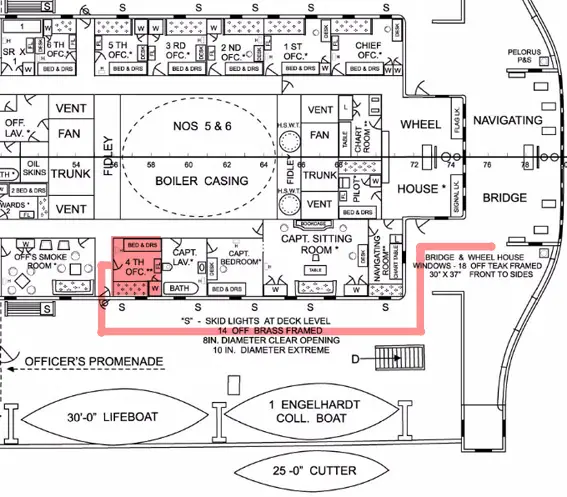
The route from Fourth Officer Boxhall's cabin (highlighted) to the bridge. Half-way along this route is when the collision occured.
(Deck plan: Encyclopedia Titanica )
At the British Inquiry he also said that he "heard the bells first… Just coming out of the officer's quarters." (British Inquiry). In 1962 he described even more precisely that he "walked along to the bridge about sixty feet away on the same deck. I was about half way between the Officer's Quarters, the entrance of the Officer's Quarters and the Bridge when the crash came." (BBC, 1962)
In 1959 he described that he "had just looked into his cabin when he heard the lookout sound three bells. He immediately went out on deck again, and a few minutes later, at about 10.40 p.m.[sic], when the ship struck, he felt no more than a slight tremor." ("A Talk by the Fourth Officer of the Titanic", May 1959 The Nautical Magazine, pages 262 - 264)
The collision itself was allegedly "only a moment or two after "the three bells" (British Inquiry) and was so slight that Boxhall thought "it did not seem to me to be very serious. I did not take it seriously" to the extent that it did not stop his walk to the bridge. He also described it as a "slight impact" (US Inquiry) and "there was not much of a shock to feel." (British Inquiry). In 1962 he explained that "when the crash came… it didn't break my step. She was doing full speed and it didn't break my step." (BBC, 1962)
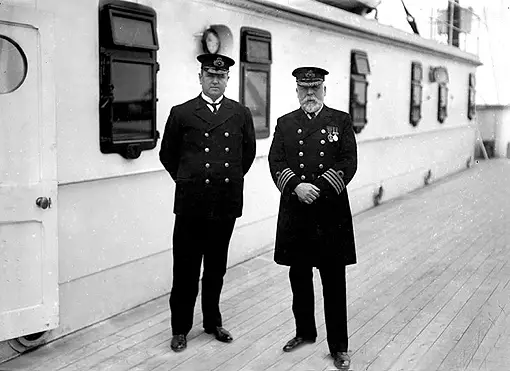
Captain Smith with Purser McElroy outside the door way to the Officer Quarters, 11th April, 1912. This shows the location where Boxhall would walk four days later, from the door on the left, along to the bridge area in the background.
(Click to enlarge)
The Iceberg
Did Boxhall actually see the iceberg at the moment of collision? At the US Inquiry he initially said he did not:
Senator SMITH. Could you see what had occurred?
Mr. BOXHALL. No, sir; I could not see what had occurred.
Senator SMITH. Did you know what had occurred?
Mr. BOXHALL. No, not at all. I heard the sixth officer say what it was.
Senator SMITH. What did he say that it was?
Mr. BOXHALL. He said we had struck an iceberg. (US Inquiry)
But then later he indicated he had an idea of what it looked like:
Senator SMITH. Did you see this iceberg at that time?
Mr. BOXHALL. Not at that time.
Senator SMITH. Did it extend above the deck that you were on?
Mr. BOXHALL. Oh, no, sir, it did not extend there.
Senator SMITH. A little lower?
Mr. BOXHALL. Yes, sir.
Senator SMITH. Do you know whether it struck the bow squarely?
Mr. BOXHALL. It seemed to me to strike the bluff of the bow.
Senator SMITH. Describe that.
Mr. BOXHALL. It is in the forward part of the ship, but almost on the side.
Senator SMITH. On which side?
Mr. BOXHALL. It is just where the ship begins to widen out on the starboard side...
In ordinary parlance, would it be a glancing blow?
Mr. BOXHALL. A glancing blow. (US Inquiry)
In 1959 he also offered a description; "The berg itself was quite a small one (it did not reach above the ship's rail), and was of the capsized type, hence it was of the blue underwater ice that is free of any of the crystallization that normally reflects even starlight." ("A Talk by the Fourth Officer of the Titanic", May 1959, The Nautical Magazine, pages 262 - 264).
The apparent contradiction could be explained by the fact that he later described looking at the iceberg with the Captain and Murdoch after the collision, so perhaps his description is based on this. Indeed, in 1913 during the Ryan vs OSNC court case he described how "he looked over the side and thought he saw a dark mass with no light about it." However, if he was walking along the starboard boat deck at the time of the collision, why did he not see the iceberg, which according to other reports was a little taller than the boat deck? Perhaps an explanation is that he could not see it as his view was at that moment obscured by the row of lifeboats on the forward starboard boat deck.
11:40pm Hard-a-starboard!
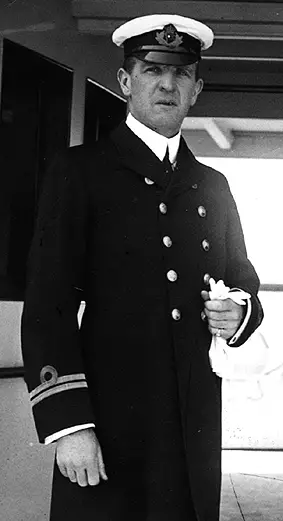
Boxhall hears First Officer Murdoch shout
"hard-a-starboard!" from a similar position
on the bridge as pictured here aboard
Olympic, 1911. (Click to enlarge)
Boxhall is one of only three surviving crew to relate what occurred on the bridge in regard to actions taken by First officer Murdoch to avoid the iceberg (the other two are Robert Hichens, a quartermaster who was at the wheel, and Alfred Olliver also a quartermaster who arrived on the bridge at approximately the same time as Boxhall).
Boxhall describes the actions he heard at the US Inquiry in the following:
Mr. BOXHALL. Three bells were struck.
Senator SMITH. Three bells?
Mr. BOXHALL. That signifies something has been seen ahead. Almost at the same time I heard the first officer give the order "Hard astarboard," and the engine telegraph rang.
Senator SMITH. What did the order mean?
Mr. BOXHALL. Ordering the ship's head to port.
At the British Inquiry he stated something similar:
15346. Did you hear an order given by the First Officer?
-I heard the First Officer give the order, “Hard-a-starboard,” and I heard the engine room telegraph bells ringing.
15347. Was that before you felt the shock, or afterwards?
- Just a moment before.
15348. (The Commissioner.) Let us be clear about that. The order, “Hard-a-starboard,” came between the sound of the bells and the collision?
- The impact, yes.
It is interesting to note in both of these accounts he does not mention he heard "full astern".
In 1959 he also added that "As he walked forward he heard the alarm bells ringing for the closing of the watertight doors" ("A Talk by the Fourth Officer of the Titanic", May 1959, The Nautical Magazine, pages 262 - 264)
Captain Smith's Conversation with Murdoch
Just after the iceberg impact Boxhall arrives on the bridge. Perhaps, as he did not think it "serious" he had not quickened his pace to get to the bridge. On arrival he finds Sixth officer Moody, First officer Murdoch and Captain Smith.
At the US Inquiry he states:
"The captain said, 'What have we struck?' Mr. Murdoch, the first officer, said, 'We have struck an iceberg.'… Mr. Murdoch followed on to say, 'I put her hard astarboard and run the engines full astern, but it was too close; she hit it.'... Mr. Murdoch also said, 'I intended to port around it.'... 'But she hit before I could do any more.' Mr. Murdoch continued to say, 'The water-tight doors are closed, sir.'…and the captain asked him if he had rung the warning bell…He said, 'Yes, sir.' " (US Inquiry)
Then at the British Inquiry he gave the following very similar description, firstly noting that he saw Murdoch closing the watertight doors by "pulling the lever." and that the "Captain was alongside of me when I turned round". The Captain then "asked him what we had struck….The First Officer said, “An iceberg, Sir. I hard-a-starboarded and reversed the engines, and I was going to hard-a-port round it but she was too close. I could not do any more. I have closed the watertight doors.” The Commander asked him if he had rung the warning bell, and he said “Yes.”
In 1962 he summarised it this way:
"I got to the bridge, and the Captain had evidently arrived about the same moment, and I heard him say to Murdoch, 'What, What is the matter? What have you struck?' He said, 'we've struck an iceberg Sir.' He said, 'I'm going Full Speed Astern, Sir, on the Port Engine.'” (BBC radio interview October 1962)
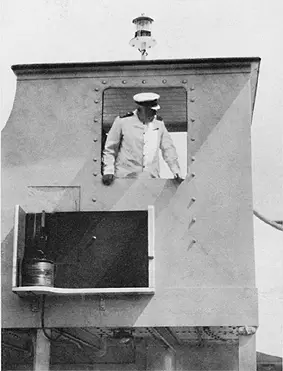
Captain Smith leaning out of the starboard
wing cab of the Olympic, as he would later
moments after Titanic's brush with an iceberg.
(Click image to enlarge)
After Murdoch's explanation of his actions, Smith, Murdoch and Boxhall go to the starboard wing bridge to see if they can see the iceberg. At the US Inquiry he explained that they "I walked out to the corner of the bridge then to look at the iceberg... The captain, first officer, and myself... I was not very sure of seeing it. It seemed to me to be just a small black mass not rising very high out of the water, just a little on the starboard quarter…I could not judge the size of it, but it seemed to me to be very, very low lying…the ship was past it then. It looked to me to be very, very low in the water. In my own opinion I do not think the thing extended above the ship's rail."
As Boxhall has not see the iceberg as it passed Titanic and now "seemed" to see it after they had passed it his estimate as to its height is understandably not very accurate. Quartermaster Olliver, who was in a similar location to Boxhall described the iceberg as "about the height of the boat deck; if anything, just a little higher. " (US Inquiry)
At the British Inquiry Boxhall explained that he "was not too sure of seeing it. I had just come out of the light, and my eyes were not accustomed to the darkness" He said that they went to view the iceberg "Only a couple of minutes" after the collision and "it appeared to me, what I fancy I saw, about a ship’s length away from the ship’s bridge…I fancied I saw a black mass, a low-lying black mass on the quarter… That is only an approximate distance you understand; it might have been more… It might have been three ship’s lengths… You must understand I had just come out of the light into the darkness and my eyes were not accustomed to it." (British Inquiry)
As Captain Smith was looking at the iceberg, Murdoch "pointed at it - like that." (British Inquiry)
Full speed astern?
One notable aspect of Boxhall's description of the collision sequence is his mention of "full speed astern". Although he did not hear it called out as he approached the bridge, he puts the words in Murdoch's mouth during the conversation with Captain Smith, saying that he ran "the engines full astern" (US Inquiry) "reversed the engines" (British Inquiry) and "Full Speed Astern, Sir, on the Port Engine" (BBC interview October 1962).
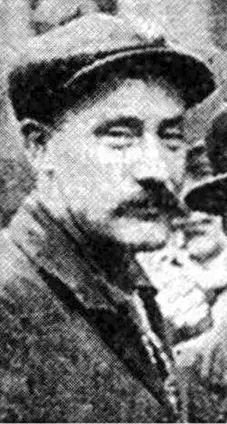
Thomas Dillon in the engine room at the
time of collision only reported the engines
were "stopped" and then "half a minute"
later "they went slow astern."
However Boxhall is the only one person to mention the full astern order. Quartermaster Robert Hichens was at the wheel and only heard the order "hard-a-starboard" when he testified at both inquiries. Quartermaster Alfred Olliver (only questioned at the US Inquiry) only heard "hard a port" as he arrived on the bridge. Frederick Barrett, Leading Fireman working in boiler room 6 only reported 'the red-light signal to stop' (US Inquiry). Trimmer Thomas Dillon in the engine room reported the engines were "stopped" after the collision and then "half a minute" later "they went slow astern." (British Inquiry)
Reasons that most likely Boxhall's "full speed astern" did not happen:
1. No first-hand eyewitness testimony to the order being given (from those in the bridge/engine room/boiler rooms)
2. No eye-witness testimony to the effects of full astern (there would be noticeable movement) e.g. Lightoller does not believe the ship was ever ordered "full astern" notably saying that "I cannot say I remember feeling the engines going full speed astern." (British Inquiry)
3. The only 'witness' to this order - Fourth officer Boxhall - was not on the bridge at the time the order would have been given and also does not report hearing it, only "hard-a-starboard". He only mentions "full astern" when he puts the words in Murdoch's mouth during the conversation with Captain Smith. And later in 1962 changes this to "full speed astern on the port engine." so it is unreliable.
4. Mechanically, there was not enough time for the engines to be able to reverse in time.
5. Reversing the engines would reduce Titanic's ability to turn (Murdoch was very experienced and would know that).
One important factor to note is that Boxhall was not in the bridge area at the time the orders were given so any information he provides is second-hand. As Hichens reported "from what I am given to understand, Mr. Boxhall was approaching the bridge" (British Inquiry). And Boxhall himself said "I was almost on the bridge when she struck." (British Inquiry).
At the British Inquiry he was directly asked: "And you knew the engines were reversed, full speed astern?" But instead of answering yes, he does not directly answer the question but replies: "I heard the bells ring, but I did not know what the movement was until I got to the bridge." (British Inquiry)
It was when he arrived on the bridge that he saw the telegraphs showing "full speed astern" (British Inquiry). Also during the Ryan vs OSNC court case in 1913 he clarified that "he was between the officers’ quarters and the bridge at the time of the collision. He saw the engine room telegraph. It pointed to full speed astern." This indicates he made an assumption based on the telegraph. However, it seems more likely that what he saw were the engine telegraphs set to "slow astern" as reported by Trimmer Tom Dillon in the engine room. Murdoch and /or Captain Smith was likely reducing Titanic's speed to then investigate the damage.